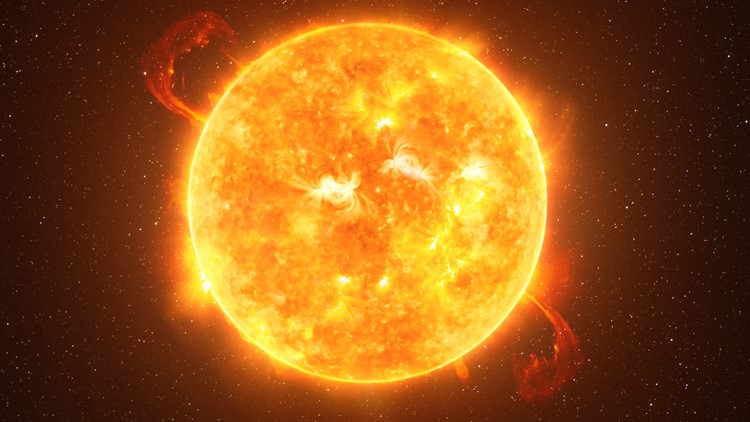ST. PETERSBURG, Fla. — A group of scientists led by prominent astrophysicist Scott McIntosh at the National Center for Atmospheric Research (NCAR), widely respected as a leading institution in the atmospheric and related sciences, has predicted that a new solar cycle could be one of the strongest on record.
The solar cycle is the cycle that the sun’s magnetic field goes through approximately every 11 years.
The current solar cycle is known as Solar Cycle 25 and just began in late 2020. While NCAR predicts a historically strong solar cycle, a NASA panel forecast calls for the new solar cycle to be similar to the just completed and feeble Solar Cycle 24.
Record keeping of solar cycles began in 1755 with Solar Cycle 1.
So what is a solar cycle? The sun is a huge ball of electrically-charged hot gas. The sun’s high temperatures cause these charged gas to constantly move, generating a powerful magnetic field. The sun's magnetic field goes through a cycle, called the solar cycle.
In areas where the magnetic fields are exceptionally strong, we see these dark spots, called sunspots, on the surface of the sun. It’s like a storm on the sun. The more sunspots we see, the more solar activity there is.
Solar Cycle 24 was a weak cycle, peaking with a maximum sunspot number of 116 sunspots (the average is 179). In their report in Solar Physics, the forecast is for Solar Cycle 25 to have a maximum sunspot number of somewhere between 210 and 260.
This would be one of the most active cycles ever observed. NASA projects a peak of 115 sunspots, similar to the cycle just completed.
According to the report, they believe that the sun has alternating 22-year magnetic cycles that interact to produce the well-known, nearly 11-year sunspot period as a by-product.
Forecasting sunspots is important since solar flares and coronal mass ejections (CMEs) that originate from them can send disruptive bursts of magnetic energy toward Earth.
A solar flare is a sudden flash of increased brightness on the sun, usually observed near its surface and in close proximity to a sunspot group. Powerful flares are often, but not always, accompanied by a coronal mass ejection.
CMEs are massive explosions of large pieces of magnetic energy hurled from the sun into space at speeds up to several million miles per hour. Even though the sun is about 93 million miles away, they can reach Earth in one to three days.
Big solar cycles can be problematic for Earth.
Satellites are integral for global economies and commerce. Energy from these solar storms can cause things to fall out of low Earth orbit more quickly by changing the density the satellites are in. This slows them down and can take them out of orbit.
Solar storms can also disrupt or destroy the electronics onboard satellites. This can cause billions of dollars in damage to the world’s high-tech infrastructure—from GPS navigation to power grids to air travel to financial services.
Solar activity can also have some effect on our global temperature. According to the Farmers’ Almanac, NOAA scientists have concluded that four factors determine global temperatures: carbon dioxide levels, volcanic eruptions, Pacific El Niño pattern and the sun’s activity.
The biggest solar storm ever recorded was the infamous Carrington Event in early September 1859.
According to History.com, on the morning of Sep. 1, 1859, amateur astronomer Richard Carrington ascended into his observatory near London. Looking into the clear blue sky, he pointed his telescope toward the sun and began to sketch a cluster of enormous dark spots that freckled its surface. Suddenly, Carrington spotted what he described as “two patches of intensely bright and white light” erupting from the sunspots. Five minutes later the fireballs vanished, but within hours their impact would be felt across the globe.
That night, telegraph communications around the world failed with sparks shocking operators and setting papers on fire. All over the planet, colorful auroras illuminated the nighttime skies, glowing so brightly that birds began to chirp and laborers started their daily chores, believing the sun had begun rising. Some thought it was the end of the world. The massive solar flare had the energy of 10 billion atomic bombs.
A similar storm today could cost the U.S. trillions of dollars. Some even speculate that a solar storm of that magnitude would bring the world’s economy to a screeching halt, with electrical service restoration taking months.
While not all scientists agree with the NCAR forecast, the study was supported by the National Science Foundation and NASA's Living With a Star Program.
- Your COVID-19 vaccine questions, answered: Do I need to be a Florida resident?
- Gov. Ron DeSantis and CNN reporter get into heated exchange over state's vaccine rollout
- How to claim your missing $1,200 stimulus check
- How to watch Alex Trebek's final 'Jeopardy!' episodes
- Read the full transcript of President Trump's call with Georgia's Sec. of State
- County-by-county COVID-19 vaccine information for Tampa Bay seniors
►Breaking news and weather alerts: Get the free 10 Tampa Bay app
►Stay In the Know! Sign up now for the Brightside Blend Newsletter



